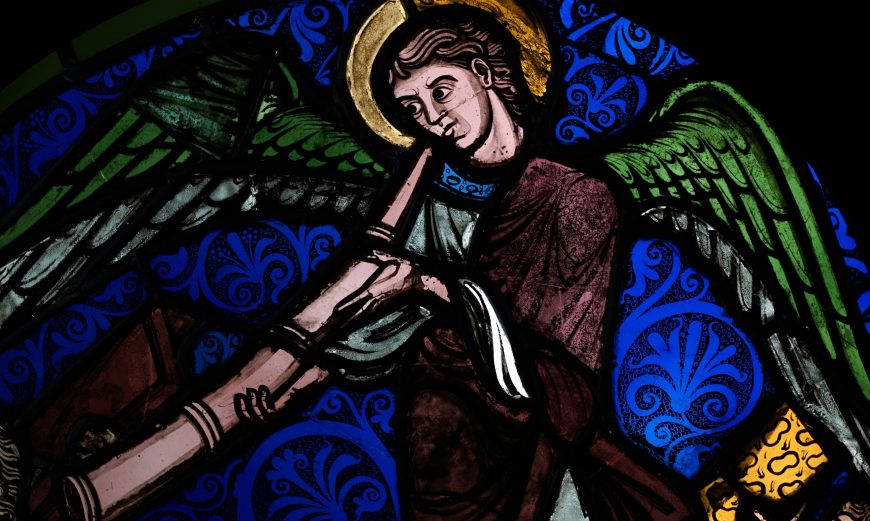
Angel awakening the dead at the Last Judgment (Cluny), Sainte-Chapelle, Île de la Cité, Paris, 1248 (photo: Dr. Steven Zucker, CC BY-CA-SA 2.0)
At Smarthistory, we produce short (usually 4-8 minute) videos that are almost always about single works of art or architecture. An important goal is to encourage close looking. Though we begin with the single object (or monument or site), we combine formal analysis with historical context and any other approaches that are useful.
How do we do it?
Our audio recordings are unscripted and last about 10-20 minutes in their raw form. They are conversations and made on-site, in front of the work being discussed (in almost all cases). We use a Zoom H2N audio recorder.
It surprises some people to find out that we do not use a video camera (or shoot any video). We take extensive photographs of the work right after we record (see our photography tutorial for tips).
We do considerable editing on the audio files to bring them down to 4-8 minutes. We edit our photos, as well. We do additional image research as necessary to gather contextual or comparative images, maps, or other materials to augment what is being discussed. We also custom-create maps or diagrams as needed. These elements are joined to create a video, along with annotations that help point out details and further explain specialized terms.
Why a single work?
We usually record a discussion about one object, in part because that is how art history is generally taught at the introductory level. One object also helps the conversation stay on track, and gives us a lens to talk about other artworks, historical or cultural circumstances, the artist’s life, etc. We do make some thematic and introductory videos that treat more than one object, and these are more complex to produce.
Why 4-8 minutes?
The Internet is full of distractions. Because of this, we try to keep our videos short and the images moving to encourage viewers to remain engaged (while covering as much information as possible). Of course, some of our videos are shorter than 4 minutes, and some are longer than 8—it all depends on the complexity of the topic.
Why an unscripted conversation?
We hear frequently that learners find it easier to listen to the back-and-forth of an unscripted conversation than to listen to a single voice reading a prepared talk. The spontaneous nature of an unscripted conversation brings a sense of the unexpected to the audio, helping to keep listeners engaged. In the era of YouTube, the informality of the unscripted conversation also communicates a sense of intimacy and sincerity. Providing different opinions and viewpoints better represents the Humanities with its emphasis on interpretations rather than answers.
Why record on-site?
We think it is important—when possible—to bring our viewers to the work of art or architecture. Art history textbooks and classroom images often divorce works of art from their context, whether that’s a museum, a chapel or archaeological site. Recording on location, with the background noise of people moving through the museum or the traffic going by, brings an immediacy to our videos—and our users notice and appreciate that.
Why don’t we show video of ourselves talking?
Our method (using an audio recorder and taking photographs) is much less expensive and time-consuming than filming with video. Filming people in motion requires proper lighting and video technique, expensive cameras, and makes editing much more difficult. Plus, being on camera is a very advanced skill that doesn’t come naturally to most people. Film yourself and you’ll see why! In addition, museums often do not allow video recording, even if they allow photography.
Finally, and most importantly, we want the viewers’ visual attention focused on the art, and not on us.
Other methods
Ours is not the only way to make a video or audio. Here are some examples of different approaches:

